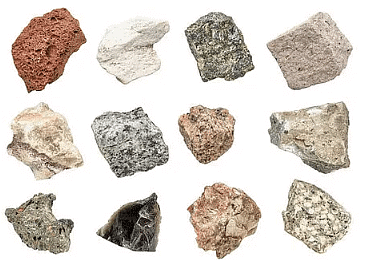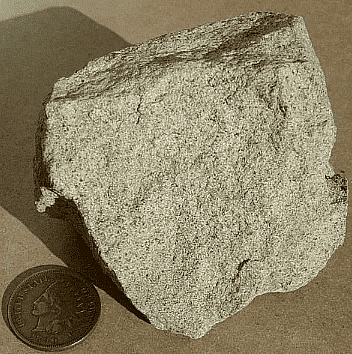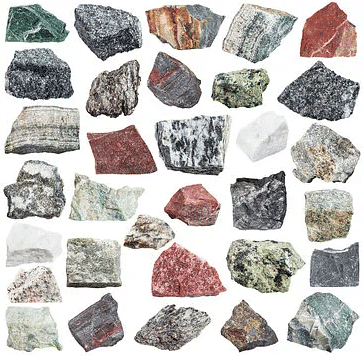Stone | Civil Engineering SSC JE (Technical) - Civil Engineering (CE) PDF Download
STONES
Classification of Rocks: Building stones are obtained from rocks occurring in nature and classified in three ways.
1. Geological classification
2. Physical classification
3. Chemical classification
1. Geological classification: According to this classification, the rocks are of the following types.
(a) Igneous rocks: Rocks that are formed by cooling of Magma (Molten or pasty rocky material) are known as igneous rocks. Eg. Granite, Basalt and Dolerite etc.
(b) Sedimentary rocks: These rocks are formed by the deposition of products of weathering on the pre-existing rocks. Eg. Gravel, sandstone, limestone, gypsum, lignite etc.
(c) Metamorphic rocks: These rocks are formed by the change in character of the pre-existing rocks. Igneous as well as sedimentary rocks are changed in character when they are subjected to great heat and pressure, known as metamorphism. eg: Quartzite, Schist, Slate, Marble and Gneisses.

2. Physical Classification: This classification is based on general structure of rocks. According to this, the rocks are classified into three types.
(a) Stratified Rocks: These rocks possess planes of stratification or cleavage and such rocks can be easily split along these planes.
(b) Unstratified rock: The structure may be crystalline granular or compact granular. Example: igneous rocks and Sedimentary rocks affected by movements of the earth.
(c) Foliated Rocks: These rocks have a tendency to split up in a definite direction only. Ex: Metamorphic rocks.
3. Chemical Classification: According to this classification rocks are classified into three types.
(a) Siliceous rocks: In these rocks, silica predominates. The rocks are hard, durable and not easily affected by weathering agencies. Ex. Granite, Quartzite, etc.
(b) Argillaceous rocks: In these rocks clay predominates. The rocks may be dense and compact or may be soft. Ex: Slates, Laterites etc.
(c) Calcareous rocks: In these rocks, calcium carbonate predominates. The durability of these rocks will depend upon the constituents present in surrounding atmosphere. Ex: Lime stone, marble etc.
GRANITE :
1. Igneous rock
2. Composed of quartz, feldspar and mica and mineral
3. Available in grey, green brown and pink and red
4. Hard and durable
5. High resistance to weathering
6. The texture varies with its quality
7. Specific gravity: 2.7 and compressive strength: 700 to 1300 kg/cm2
8. Used for ornamental, road metal, railway ballast, aggregate for concrete; for construction of bridges, piers and marine work etc.
BALLAST:
1. Igneous rock
2. It is compact, hard and heavy
3. Available in red, yellow, grey, blue and greenish black colours.
4. Specific gravity is 3 and compressive strength varies 1530 to 1890 kg/cm2.
5. Used for ornamental, rail road ballast, aggregates for concrete etc.
SAND STONE:
1. Sedimentary rock
2. it is available in variety of formations fine grained, coarse grained compact or porous
3. Available in white, green blue, black, red ,yellow.
4. Specific gravity 2.65 to 2.95
5. Compressive strength is 650 kgs/cm2
6. Used for ashlar works.
Lime Stone:
1. Sedimentary rock: It is available in a variety of forms which differ from one another in colour, Compaction texture, hardness and durability.
a. Compact lime durable
b. Granular lime stone
c. Magnesia lime stone
d. Kanker limestone
e. Used for paving, road metal, etc.
MARBLE:
1.Metamorphic rock
2.Available in white, blue, green yellow black and red colour
3.Highly compact
4.Suitable for decorative works, wall lining columns, pile, table slabs, hearths, tiled floors, steps of stair case etc.
SLATE:
1. Metamorphic rock
2. Non absorbent, compact fine grained and produce metallic ringing sound when struck
3. Available in black, dark blue, grey, reddish brown etc.
4. Used for providing damp proof course, paving dados etc.
By arbitrary standards: it is a commonly adopted method of proportioning the aggregates in a concrete mix for small or moderate importance. This method is not recommended for large works or important woks in this method, the volume of cement, sand and coarse aggregates are taken in the proportion of 1 : n : 2n respectively.
The quantity of water to be used is varied to suit the required workability.
Ex:
1 : 1 : 2 – M 250 rich mix for columns, beams
1 : 1 : 3 – M 200 water retaining structures etc
1 : 3 : 6 – M 100 – foundations,
1 : 4 : 8 – For mass concrete
|
2 videos|133 docs|55 tests
|
FAQs on Stone - Civil Engineering SSC JE (Technical) - Civil Engineering (CE)
| 1. What is the importance of frequent handwashing during the COVID-19 pandemic? |  |
| 2. Is hand sanitizer as effective as soap and water in killing the COVID-19 virus? |  |
| 3. How often should I wash my hands to prevent COVID-19 transmission? |  |
| 4. Can I use hand dryers to dry my hands after washing them? |  |
| 5. What should I do if soap and water are not available for handwashing? |  |

















